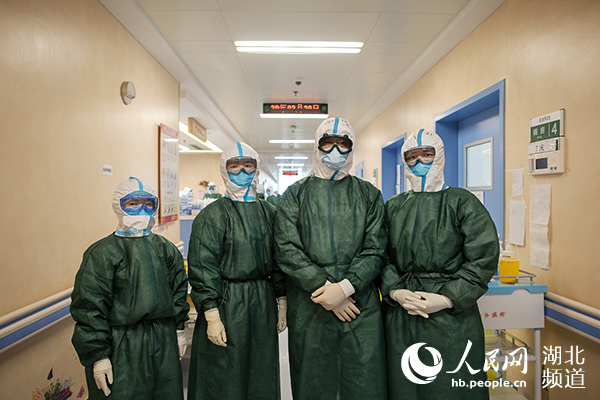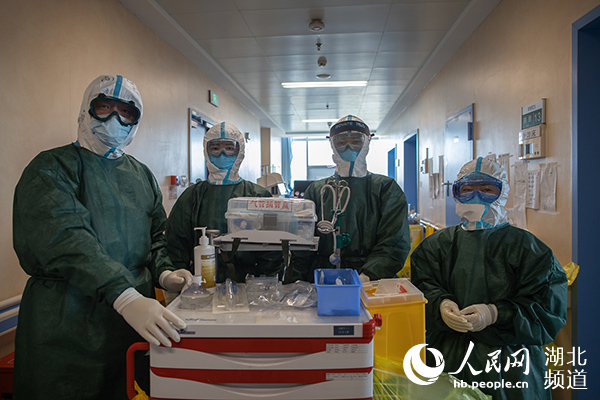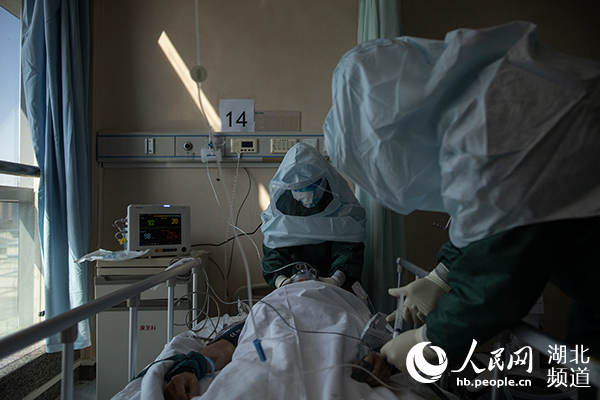


Eighteen anesthesiologists from five hospitals in the coronavirus-hit city of Wuhan recently formed a team to undertake the task of emergency endotracheal intubation for severely ill patients with the novel coronavirus disease (COVID-19) in Tongji Hospital affiliated to Huazhong University of Science and Technology.
Severely ill patients confirmed to have the disease may develop respiratory failure, making the treatment more difficult. Therefore, endotracheal intubation becomes vital to bring back more lives. As a result, the team was formed to treat sick individuals of 16 inpatient areas as well as one ICU at a hospital.

Gao Feng, director of the Department of Anesthesiology in Tongji Hospital, said that procedures involving emergency endotracheal intubation can be extremely risky, especially for severe cases, due to patients’ poor physical condition, inability to tolerate prolonged hypoxia, and severe fluctuations in blood pressure and heart rate. “Therefore, it must be conducted by extremely experienced anesthesiologists.”
To successfully complete the task, the team set up a unified standard, including personal protection, preparation of articles and intubation procedures, and adhering to a “zero error” principle.
Although endotracheal intubation may seem like a routine medical procedure, each doctor has his own habits and techniques. In order to meet the diversified needs of all anesthesiologists, the Department of Anesthesiology has prepared a “multifunctional toolbox”, which meets the diversified needs of each and every doctor. All necessary items are placed inside for intubation, such as narcotic drugs, vasoactive drugs, disposable intubation appliances and intubation supplies.

“Normally, it takes 15 to 20 minutes to complete an intubation, but with protective suits and three layers of gloves, the field of vision of doctors is severly impaired and movement would all be affected, said Gao. For example, on February 16, two team members on duty were only ale to complete endotracheal intubations for six severely ill patients over a six hour period.
In fact, endotracheal intubation is high-risk, because when anesthesiologists operate in close proximity to an infected person, virus-laden aerosol droplets from the patient may cause person-to-person transmission. “But if we don’t do it, who will?” team members said.
For the past eight days, the team has successfully completed nearly 50 endotracheal intubations, with a 100 percent success rate. The oldest patient was 85 years old.
When an anesthesiologist rushes up, it means the patient is in critical condition. As the extremities surrounding the procedure clarify explained above, the endotracheal intubation team is always in decisive battles against death, said Gao.
 Fire brigade in Shanghai holds group wedding
Fire brigade in Shanghai holds group wedding Tourists enjoy ice sculptures in Datan Town, north China
Tourists enjoy ice sculptures in Datan Town, north China Sunset scenery of Dayan Pagoda in Xi'an
Sunset scenery of Dayan Pagoda in Xi'an Tourists have fun at scenic spot in Nanlong Town, NW China
Tourists have fun at scenic spot in Nanlong Town, NW China Harbin attracts tourists by making best use of ice in winter
Harbin attracts tourists by making best use of ice in winter In pics: FIS Alpine Ski Women's World Cup Slalom
In pics: FIS Alpine Ski Women's World Cup Slalom Black-necked cranes rest at reservoir in Lhunzhub County, Lhasa
Black-necked cranes rest at reservoir in Lhunzhub County, Lhasa China's FAST telescope will be available to foreign scientists in April
China's FAST telescope will be available to foreign scientists in April "She power" plays indispensable role in poverty alleviation
"She power" plays indispensable role in poverty alleviation Top 10 world news events of People's Daily in 2020
Top 10 world news events of People's Daily in 2020 Top 10 China news events of People's Daily in 2020
Top 10 China news events of People's Daily in 2020 Top 10 media buzzwords of 2020
Top 10 media buzzwords of 2020 Year-ender:10 major tourism stories of 2020
Year-ender:10 major tourism stories of 2020 No interference in Venezuelan issues
No interference in Venezuelan issues
 Biz prepares for trade spat
Biz prepares for trade spat
 Broadcasting Continent
Broadcasting Continent Australia wins Chinese CEOs as US loses
Australia wins Chinese CEOs as US loses